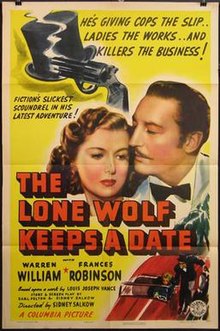The Lone Wolf Keeps a Date
| The Lone Wolf Keeps a Date | |
|---|---|
 Theatrical release poster | |
| Directed by | Sidney Salkow |
| Screenplay by | Sidney Salkow Earl Felton |
| Based on | Lone Wolf by Louis Joseph Vance |
| Produced by | Irving Briskin |
| Starring | Warren William Frances Robinson Bruce Bennett |
| Cinematography | Barney McGill |
| Edited by | Richard Fantl |
| Music by | Sidney Cutner |
Production company | |
| Distributed by | Columbia Pictures |
Release date | November 23, 1940 |
Running time | 65 minutes |
| Country | United States |
| Language | English |
The Lone Wolf Keeps a Date (1941) is the sixth Lone Wolf film produced by Columbia Pictures. It features Warren William in his fourth appearance as the title character Lone Wolf, and Edward Gargan, Lester Matthews and Don Beddoe as the film's antagonists. The film was directed by Sidney Salkow and written by Salkow and Earl Felton.
The film centres on former jewel thief Michael Lanyard, also known by his alias "Lone Wolf," aiming to recover his stamp collection as well as rescuing a damsel in distress. Filming took place in August and September 1940. The Lone Wolf Keeps a Date was theatrically released in the United States in January 1941.
Plot
After adding a rare Cuban stamp to his coveted collection and admonishing his butler Jamison for winning money in a rigged dice game in Havana, retired jewel thief and unofficial private detective Michael Lanyard (a/k/a "The Lone Wolf"), flies off to Miami, meeting gorgeous Patricia Lawrence on board the flying boat. Initially reserved, Lawrence decides to confide in Lanyard about her troubles — one of her mail-sender boyfriend Scotty's clients was killed some time ago, after retaining Scotty to send a package stuffed with $100,000 in bank notes. Descending at the Miami airport, they are ambushed by kidnappers Chimp, Mr. Lee, employees of Big Joe Brady. The Lone Wolf swiftly outruns the criminals with Lawrence. He hides the retrieved stack of money in a hotel safe, but he's is discovered by Inspector Crane and his annoyingly buffoonish assistant Detective Sergeant Wesley Dickens, along with goofy Miami police Captain Moon. Lanyard evades capture and sets out to expose the three villains on his own. The detective also realizes that his prized stamp collection has also been swiped by Big Joe Brady. He manages to track them down and has the police arrest them. After myriad chases, double-crosses and switches, The Lone Wolf exonerates himself and mulls over missing an important philatelist's convention with his finally retrieved prize collection.
Cast
- Warren William as Michael Lanyard
- Frances Robinson as Patricia Lawrence
- Bruce Bennett as Scotty
- Eric Blore as Jamison
- Thurston Hall as Inspector Crane
- Jed Prouty as Captain Moon
- Fred Kelsey as Dickens
- Don Beddoe as Big Joe Brady
- Lester Matthews as Mr. Lee
- Edward Gargan as Chimp
- Eddie Laughton as Measles
- Mary Servoss as Mrs. Colby
- Francis McDonald as Santos the Portuguese
Production
The "Lone Wolf" title character was played by Warren William — his fourth time doing so. Eric Blore continued playing Lanyard's butler "Jamison."[1] Although Walter Baldwin is listed in studio documents as playing a "Night watchman" in the film,[1] he actually did not appear in it.[2]
Sidney Salkow served as director of the film for the production company and distributor Columbia Pictures, while Salkow and Earl Felton co-wrote the screenplay, based on the jewel-thief-turned-private-detective character created by Louis Joseph Vance (1879–1933) in a series of eight novels published between 1914 and 1934. Barney McGill signed on as cinematographer. Morris Stoloff headed the musical direction, and Richard Fantl edited the film. Principal photography by Barney McGill officially began on August 21, 1940, and ended in mid-September 1940.[1]
Release and reception
Through the release print lists the copyright date of "MCMXL" (1940), the film was officially released in North American cinemas in January 1941. It is alternatively referred to as Revenge of the Lone Wolf and Alias the Lone Wolf.[1] In his 2010 book Mystery Movie Series of 1940s Hollywood, Ron Backer generously wrote that the film "is the best of the Warren William Lone Wolf movies" although "it seems to lack that certain something that made the earlier Lone Wolf movies so entertaining." He concluded that it made "a good entry in the Lone Wolf series, with less sexual violence this time round."[3] In marked contrast, Leonard Maltin wrote for his Movie & Video Guide (1998) that the film was "listless."[4]
References
- ^ a b c d Blottner 2012, p. 242.
- ^ Blottner 2012, p. 243.
- ^ Backer 2010, p. 319.
- ^ Maltin 1998, p. 789.
Bibliography
- Gene Blottner (2012). Columbia Pictures Movie Series, 1926—1955: The Harry Cohn Years. McFarland. ISBN 978-0-7864-3353-7.
- Ron Backer (2010). Mystery Movie Series of 1940s Hollywood. McFarland. ISBN 978-0-7864-5700-7.
- Leonard Maltin (October 1998). Leonard Maltin's Movie & Video Guide. Plume. ISBN 978-0-452-27992-6.
